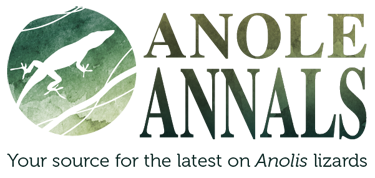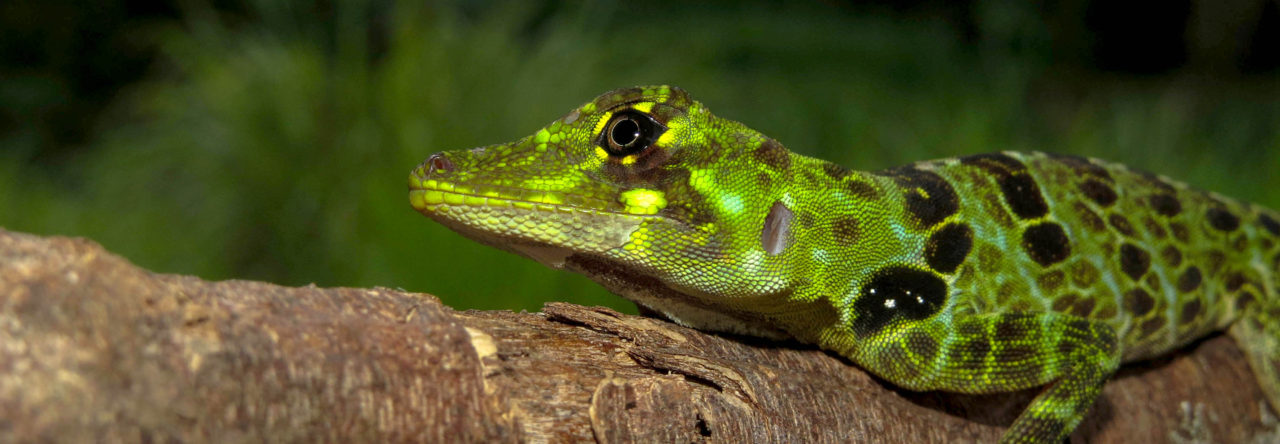Hello All, I’m an ecologist that studies species-habitat relationships, among various other things. I’m presently working on a book that will describe 10 methods of statistically analyzing habitat and also try to provide a conceptual unification of how capital-E ecologists and wildlife ecologists have traditionally viewed habitat and its importance. I’m looking for real empirical datasets to analyze. Data for Anolis species would be great given their importance in testing ecological and evolutionary theory, and their specific habitat preferences. The dataset could be for a single species or multiple species. It could have either microhabitat data (e.g., observations of Anolis individuals at different perch heights and stem diameters, tree species perched on) or macrohabitat data (e.g., amount of vegetation or canopy cover within a 10 m diameter of lizard location). Really any kind of environmental or habitat data would work. Ideally, the dataset would also have environmental data from locations where lizards were not observed (so-called absence points). If you have a dataset that you’d be willing to share please contact me at joseph.veech@txstate.edu. THANKS!
Magical Transformation Spells Brighter Future for Redonda’s Fantastic Beasts
Campaign to remove invasive rats and goats from Redonda has yielded spectacular results for the island’s unique and special wildlife.
Media Release
If conservationists had waved a magic wand, the results could hardly have been more spectacular. Within 12 months of starving goats and thousands of ravenous rats being removed from Redonda1, this remote Caribbean island has witnessed a miraculous transformation.
Since the ambitious restoration programme2 was rolled out, the rock of Redonda has been transfigured from an inhospitable lunar landscape to a greener haven. More importantly, the unique plants and animals native to this isolated, uninhabited outpost of Antigua and Barbuda are making a rapid recovery after being freed from an alien invasion.
The evocatively named Redonda ground dragon, a rare black lizard found nowhere else on the planet, has doubled in number – just one of the many fantastic beasts that have been pulled back from the brink of extinction by removing the predatory black rats and plant-devouring goats.
And it doesn’t stop there. In less than a year, numbers of the equally rare Redonda tree lizards have tripled, hundreds of new trees have sprung up, land birds have increased tenfold, and the island’s globally important seabird colonies – including magnificent frigatebirds and several booby species – are having their best breeding year on record.
Speaking on behalf of the Department of the Environment, Dr Helena Jeffery Brown said:
The Government of Antigua and Barbuda considers the return to life of Redonda as a shining beacon in our collective efforts towards ecosystem restoration and biodiversity conservation that will bring us another step closer to attaining some of the Aichi Biodiversity Targets3.”
The project’s coordinator, Shanna Challenger, of the Environmental Awareness Group (EAG) and Fauna & Flora International (FFI), added:
This has been the opportunity of a lifetime – witnessing an island be reborn. Changes forecasted to happen in five years occurred within months. Our conservation efforts really show the benefits of invasive species removal on Caribbean island ecosystems.”
“Blood, sweat, toil and teamwork”
In the field of conservation, where successful outcomes can take years if not decades to materialise, the spectacular results on Redonda appear remarkably swift.
The reality, of course, is that this ‘overnight’ transformation was a long time in the making. It took seven months of blood, sweat, toil and – above all – teamwork to catch dozens of nimble goats and remove over 6,000 rats from every inch of Redonda’s rugged terrain. This Caribbean island makeover involved meticulous planning, ingenuity, and edge-of-the-seat maneuvers that included abseiling down sheer cliff faces to lay down rat bait and, thanks to the skilled pilots of Caribbean Helicopters Ltd, landing equipment in very tight spots.
New Zealand-based Wildlife Management International Limited led the rat eradication team: “We have over 30 years of experience in clearing invasive species from islands,” said ecologist Elizabeth (Biz) Bell, “but having a ground team, rope access team and helicopter team using a combination of bait stations, hand broadcasting and aerial methods to successfully target all of the rats makes the Redonda project unique.”
The British Mountaineering Council (BMC) played a vital role in ensuring that even the steepest cliffs could be reached. Safety was paramount, as CEO Dave Turnbullrecalls:
The volcanic cliffs of Redonda presented an extremely challenging environment for the climbers to operate in; the BMC was very pleased to support this important conservation project and help ensure the safety of the team throughout the work.”
The safe removal of the malnourished herd of rare-breed feral goats presented an altogether different challenge, as Dr Karl Campbell of Island Conservation can attest:
This project was essential for the wellbeing of the goats and to enable the ecological recovery of the island. The translocation of goats has seen a suite of positive impacts, and further benefits will unveil themselves in time.”
One intriguing consequence of removing the predatory rats is that lizards on Redonda are rapidly changing their behaviour, according to scientists from Harvard University and the Museum of Natural History in Paris. “We measured anti-predator behaviour and found that the ground dragons are becoming fierce and fearless now that the rats are gone, chasing and eating even adult tree lizards”, said Dr Colin Donihue. “This new balance of nature is more in line with what we’d expect of these animals before rats were ever on the island.”
The long list of organisations that cooperated in this mission reflects the complex challenges that had to be overcome. The government of Antigua and Barbuda along with the EAG and FFI joined forces with leading technical specialists from the UK, USA and New Zealand.
Thanks to their collaborative efforts, Redonda has been rat free since March 2017 while the feral goats4 have been rehoused and are being cared for by the government’s Veterinary and Livestock Division on Antigua. Biosecurity equipment and protocols have also been installed to prevent future invasions.
What’s next for Redonda?
Redonda harbours endemic species that occur nowhere else in the world, including at least five species of reptiles, and globally important colonies of seabirds. Conservationists argue that Redonda’s unique and special wildlife, coupled with the historical remains of one of the region’s largest guano mines, warrants greater protection for the island. They’re not the only ones. A recent nationwide survey revealed that over 96% of Antiguans and Barbudans agree the island should be protected.
Preparations for designating Redonda and the surrounding sea as a reserve are now under way, led by the Redonda Steering Committee, chaired by the Department of Environment.
According to Dr Robin Moore from US-based Global Wildlife Conservation, which has supported this project and is now helping with planning for the protected area, “It’s incredible to see this radical and rapid transformation of Redonda from a bare rock to a carpet of vegetation. As plants and animals continue to rebound, this could truly be a showcase sanctuary for wildlife.”
– END –
High-resolution images are available upon request. For more information and interviews, please contact:
Sarah Rakowski | Head of Communications, Fauna & Flora International | Tel: +44 (0)1223 747 659 | sarah.rakowski@fauna-flora.org












Notes to editors:
- Redonda harbours a number of endemic species that occur nowhere else in the world, including at least five species of reptiles, such as the Redonda ground dragon (Pholidoscelis atrata). In 2015 all of the surviving reptile species were evaluated by IUCN as Critically Endangered, meaning they face an extremely high risk of extinction in the wild. Redonda has regionally and globally significant colonies of seabirds, including brown boobies, masked boobies, red‐footed boobies, magnificent frigatebirds and red-billed tropicbirds. It was internationally recognised as an Important Bird Area in 2009.The black or ship rats (Rattus rattus) that invaded Redonda were among the largest recorded members of this species and were observed hunting and killing the island’s lizards and seabirds. Diet analyses have shown they also consumed enormous quantities of plants and invertebrates.Christopher Columbus named the island in 1493 and claimed it for Spain. Redonda was later transferred to the British Crown and around 7,000 tonnes of seabird guano was harvested annually from 1865 to 1914. It is believed that rats were introduced to the island during this period. The mining community was disbanded during World War I, after which the island was uninhabited. In 1967, Redonda became a dependency of Antigua and Barbuda.
- The Redonda Restoration Programme is supported by, among others, the Darwin Initiative through UK Government funding, National Fish & Wildlife Foundation, Global Wildlife Conservation, Betty Liebert Trust, US Fish & Wildlife Service NMBCA and Syngenta Crop Protection AG.The Redonda Restoration Programme is part of a larger effort to protect global biodiversity. Forty-one percent of the world’s most highly threatened vertebrates are found on islands, with invasive species introduced to islands being a leading cause of extinction. Removing invasive species from islands is an effective and proven way to save many of our world’s most vulnerable species. To date, there have been more than 400 successful projects to remove invasive rodents from islands. The pace, scale and complexity of these efforts are increasing in recognition of the threat invasive species pose to biodiversity.
- The Aichi Biodiversity Targets form an integral part of the Strategic Plan for Biodiversity 2011- 2020 adopted by signatories to the Convention on Biological Diversity at a 2010 meeting in Nagoya, Japan. They comprise a series of strategic goals that aim to halt biodiversity loss, maintain ecosystem services and protect the variety of life on the planet that is essential to human well-being.
- The rat eradication and goat removal work was completed by June 2017, and Redonda was officially declared rat free the following year in July 2018, after an intensive three-week survey failed to uncover any signs of rodents anywhere on the island. This aligns with customary best practice, which is to wait at least one year before declaring a rat eradication operation successful. The entire population of black rats (Rattus rattus) was eradicated using Klerat, a bitter, waxy rat bait containing the active ingredient brodifacoum that has been used successfully to remove rats from dozens of Caribbean islands since the early 1990s. This was readily eaten by the rats on Redonda but ignored by the native reptiles, mammals and birds. The bait was distributed at intervals of not less than 40 metres, even down the high cliffs, to be certain of reaching every rat.The rat eradication team lived on the island for more than two months to monitor bait uptake and remove rat carcasses. The goat operation took more than six months and aimed to bring the healthiest animals back to Antigua alive at the request of the Department of Agriculture. Recent genetic tests indicate the goats, which have unusually long horns, are of Spanish origin. Most of the goats were successfully captured by hand after being shepherded along temporary fence lines, but some were caught using live snares. All of the goats were found to be very thin and stunted due to the lack of food on Redonda, but have since gained weight and begun breeding on Antigua.






















